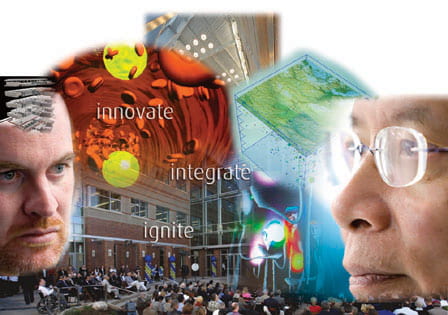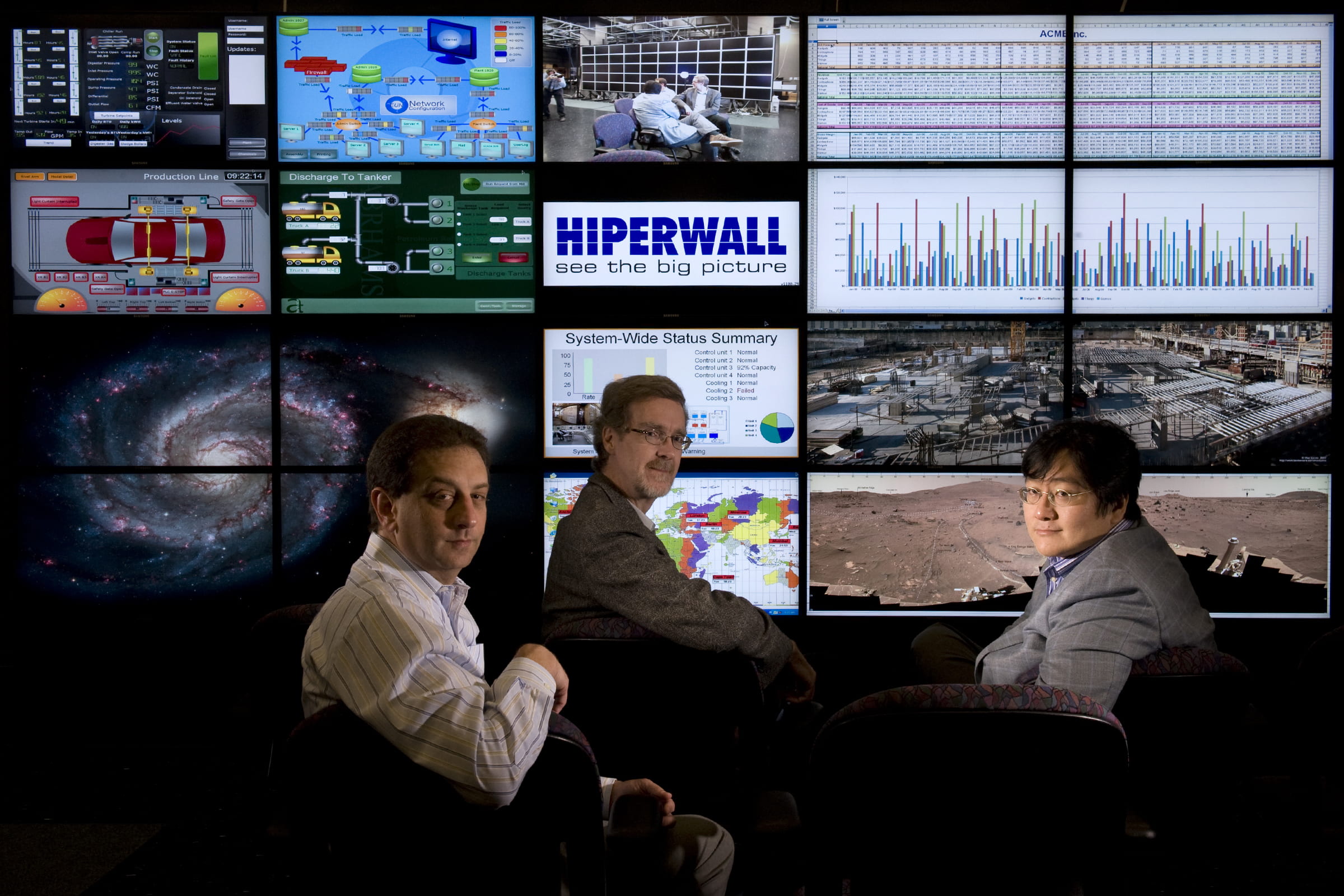Exponential gains
With a unique approach and new, state-of-the-art facility, Calit2 pioneers advances in electonic communications

With the turn of the millennium, something happened to the future. It became less extreme, less a screen for the projection of utopian or dystopian visions, and more, well, real. It arrived.
As of late November this new, bona fide future has a building on the UCI campus in which to unfold. After four years as a more-or-less virtual organization, with a skeleton staff housed in temporary quarters, the California Institute for Telecommunications and Information Technology – a.k.a. Calit2 – opened its new, 120,000-square-foot research facility to a diverse range of scientists pursuing the next generation of technologies and their applications.
Calit2 is one of four California Institutes for Science and Innovation established on nine UC campuses around the state in 2000 by former Gov. Gray Davis. The mission of the institutes is to lay the foundation here for the “next New Economy.” With a presence on both the UCI and UC San Diego campuses, Calit2 is specifically focused on fostering innovation in the fields of Internet and information technologies and their myriad applications.
NOVEL METHODOLOGIES
The institute’s methods are anything but routine. It seeks to discover real-world solutions, revealed through a unique, multilayered prism of expertise in areas as broad as networked infrastructure, socioeconomic evolution and new media arts. And dozens of industry partners, including Broadcom, Emulex, Conexant and ImageCat, are playing key roles in ensuring these creative discoveries become purposeful applications.
Innovation is Calit2’s mission, and the new building manifests that charge; its large open lab spaces allow it to adapt both to the demands of quickly evolving technologies and to the changing cast of researchers passing through it. Calit2 has no faculty of its own; all the researchers in its labs are affiliated with other campus departments – such as computer, physical, biological, and social sciences; engineering; management; and the arts – and these researchers work at the facility as long-term visiting scholars, taking advantage of the biotech labs, cutting-edge clean rooms, ultra high-speed network facilities and, perhaps even more importantly, the extraordinary opportunities for collaboration.
“We don’t own anybody on campus,” says Albert Yee, director of the Irvine division of Calit2, “but we try to know what everybody in the diverse research communities at UCI and UCSD is doing.” The commitment to collaboration runs deep at Calit2, and it, too, is reflected in the new building’s design, says Yee, a Berkeley-trained chemist-turned-engineer. Whereas nascent technologies are often born and raised in splendid isolation, especially in universities, their applications in the real world are always more complex. One of Calit2’s big ideas is to take a more holistic approach up front to the development and analysis of new technologies. It is well worth the time and effort, says Paul Dourish, a computer scientist and the associate director of research for Calit2.
For example, notes Dourish, Calit2 scientists are developing small, inexpensive chips that can quickly and cheaply perform clinical lab functions, such as blood analyses, that are currently time consuming and costly. It helps material scientists and engineers greatly to work alongside medical doctors who understand just how those chips will be employed in the real world. It also helps to have on hand telecommunications and database experts to develop ways of accumulating, sharing, securing and presenting data generated by new methods. Sociologists and lawyers, steeped in the legal and privacy issues that may arise if those chips are to be implanted into patients, contribute their perspectives to the process as well.
Multidisciplinary collaboration makes good sense from research, economic and social perspectives, says Dourish. But pulling it off requires an environment and culture absent from most university settings.
“Universities live by creativity, yet faculty members often are not encouraged to venture out of their offices,” adds Yee. “The Calit2 building and culture do just the opposite. Everything is designed to facilitate contact and collaboration.”
CLOSE COLLABORATIONS
In Calit2’s ResCUE project, for example, sociologists work alongside engineers, artists and material scientists in their efforts to help develop new and better technologies for emergency response teams. And “alongside” doesn’t mean in adjoining offices behind closed doors. It means out in the open, where elbows, imaginations and intellects rub together.
ResCUE, which stands for Responding to Crises and Unexpected Events and is supported by a $12 million National Science Foundation grant, focuses on the use of information technology in emergency response. Whether after an earthquake in Los Angeles, a hurricane in Florida or a bombing in New York, when separate response personnel come together, they need to share information with each other, their commanders and other agencies. Working with practitioners in the field, ResCUE is developing new and efficient instruments that will allow first responders to quickly relay reliable information back to headquarters; it is also developing database access models so traffic conditions, the distribution of other fire or medical personnel, and hospital bed availability, for instance, are all accessible.
Reaching out to the broader community – industry, local schools, police, hospitals – is key to the institute’s mission, says Yee, who came aboard as division director in January 2004. “Here, we stay in touch with the real world to address its real problems and possibilities.”


